Aquarray ‒ Next Generation Screening
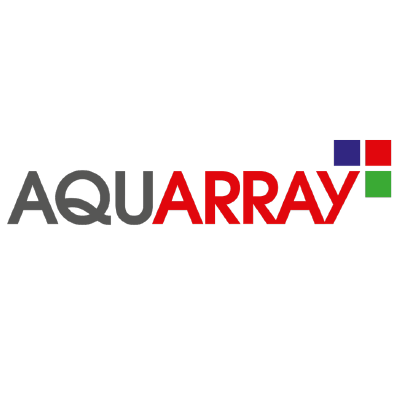
Aquarray is a German biotech company developing a proprietary technology platform, the Droplet Microarray (DMA), which enables highly miniaturized assays, screenings and analyzes. Droplet Microarrays are transparent and completely planar arrays consisting of hydrophilic spots separated by superhydrophobic barriers based on Aquarray’s patented technology. The DMAs can be used for cell-based experiments, biochemical assays, on-chip synthesis and analytics or improved MALDI-TOF sensitivity – there's almost no limit to combine different analytical methods on one platform!
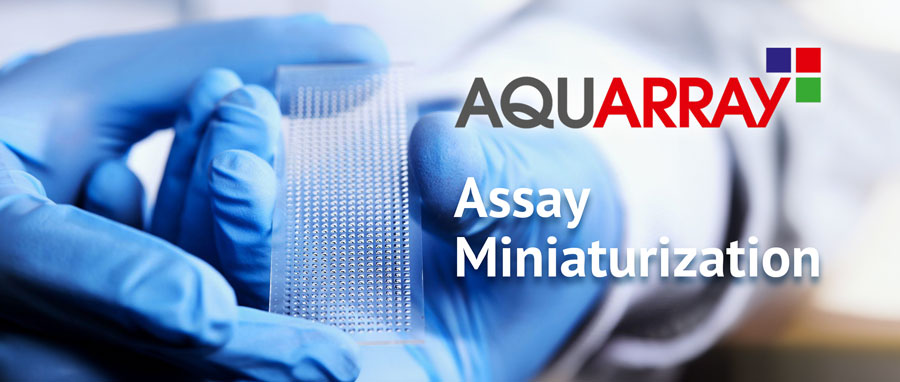
Miniaturization of Microplate Assays
Technology
Miniaturization of microplate assays beyond the 384-well format is a major technical challenge due to surface tension and capillary effects.
However, some applications, such as synthetic biology, combinatorial chemistry, process analytics, and personalized medicine require further miniaturization for reasons of applicability, availability of reagents and materials, and cost.
Aquarray's innovative Droplet Microarray (DMA) technology offers a new approach for assay miniaturization. The DMA-technology is based on a patterning process that uses high-performance nanomaterials to create planar arrays of wettable (hydrophilic or omniphilic) spots separated by a non-wettable (superhydrophobic or omniphobic) grid on transparent glass.
Aqueous solutions are trapped in the hydrophilic spots due to the extremely high surface tension. The droplets formed remain stably suspended even when the DMA is shaken or turned upside down. The technology allows the production of a wide range of patterns resulting in a range of 80 to 6048 spots per DMA and working volumes from 5000 nl down to 20 nl.
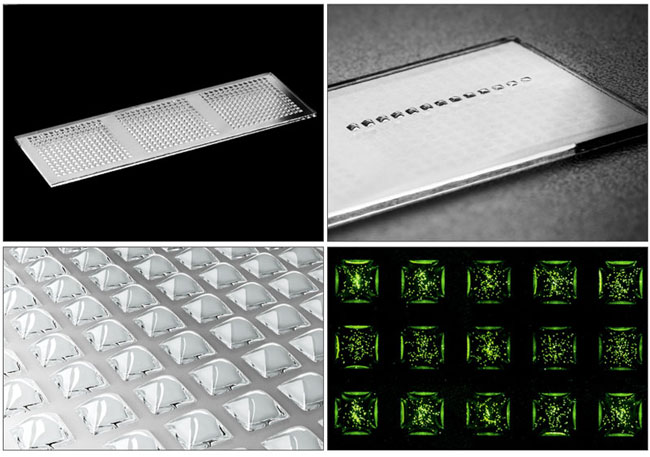
The patterning process can also be performed on alternative materials such as steel or ITO coated substrates, and can be adapted for use with low surface tension fluids such as mild organic solvents. This further extends the range of applications.
Aquarray offers you flexible and customized formats, coatings and functionalized surfaces to best meet your needs.
Customized Formats
Choose between different substrates, coating types and patterns.
Carriers
- Standard-Glass-Slide "G" ‒ This substrate is used for standard chemical and biological work.
- ITO-Glass-Slide "I" ‒ Conductive and IR-reflective properties of the additional indium tin oxide (ITO) coating make Aquarray’s Droplet Microarray compatible with applications such as on-chip MALDI-TOF mass spectrometry or IR spectroscopy.
Coatings
- Type "np" ‒ A surface compatible with aqueous media. This coating is ideal for cell culture applications. The static water contact angle of the superhydrophobic borders have a value of > 158°. The hydrophilic areas have a static water contact angle of < 10°.
- Type "dd" ‒ A surface compatible with both aqueous and organic solutions. The static water contact angle of the omniphobic borders have a value of > 108°. The omniphilic areas have a static water contact angle of < 40°.
Patterns
Droplet Microarrays are available in different formats with spot sizes ranging from 350 µm to 2,8 mm. For more information, please see Aquarray’s product catalog and / or the corresponding product pages.
Applications
With the Droplet Microarray, Aquarray enables yet with standard microplates unaffordable screening of precious, expensive and limited cells and / or compounds or even unified on-chip synthesis, characterization and biological screening.
Cell-Based Screenings
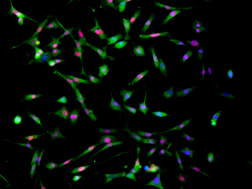
Cell-based screenings are widely used in pharma, biotechnology and cosmetic industry as well as in basic and translational research.
The DMA-platform offers a perfect solution for performing fast, affordable and reliable high-throughput screenings in nanoliter volumes.
The DMA chips can be used for screening of chemical compound libraries (e.g., approved drugs or novel chemical entities), as well as transfection mixtures (e.g., CRISPR-Cas or RNAi libraries) on different cell types, including immortalized adherent and suspension cell lines, primary and stem cells in both 2D and 3D cell culture models.
Drug Sensitivity and Resistance Tests in Personalized Medicine
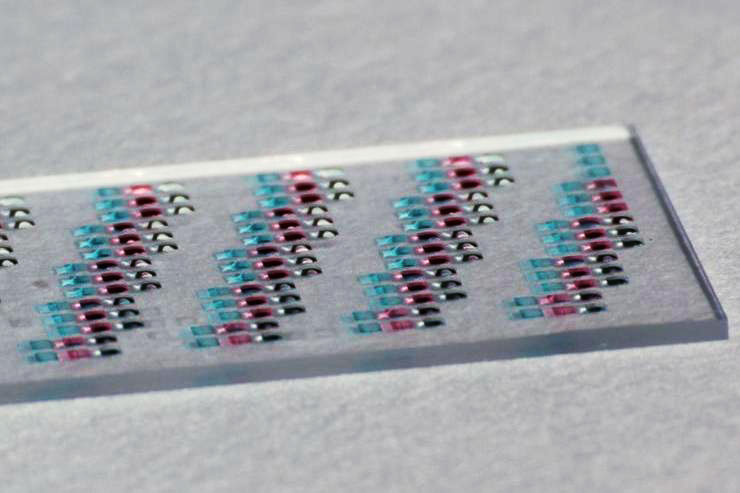
The field of precision medicine is a rapidly developing area, where the personalized treatment of a patient is facilitated through the analysis of individual markers and sensitivities. Ex vivo testing of patient cancer cells with clinically relevant panel of drugs, so called Drug Sensitivity and Resistance Test (DSRT), is an important method for empirical identification of suitable therapy for cancer patients.
The main limitation of this test is limited amount of patient material, which is often not sufficient for performing DSRT in microtiter plates. The DMA platform offers a solution for screening of minute amounts of cells in miniaturized format, at the same time allowing for more drugs and combinations to be tested on a single patient biopsy.
MALDI-MS-Based Readout
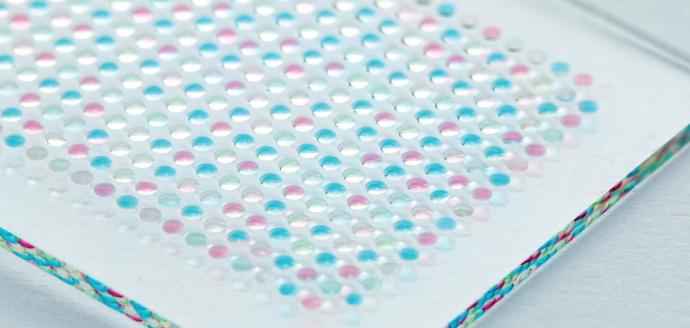
This readout is used on high-density Droplet Microarrays (DMA) facilitating next generation on-chip drug discovery.
On-chip characterization of newly synthesized compounds is particularly critical, since most existing analytical techniques are incompatible with synthesis platforms operating at low volume and concentration and a high level of parallelization. DMAs are compatible with MALDI-MS readout, which allows highly sensitive and fast characterization and detection of compounds down to attomole range.
Brochures and Flyers
Application Notes
- I-DOT One & the Droplet Microarray
- Droplet Microarray (DMA) – A Revolutionary Miniaturized Technology for High-Throughput Screening of Live Cells
- High-throughput MALDI-MS based read-out of high-density droplet microarrays facilitating next generation on-chip drug discovery
- Microdroplet Cell Cultures in 3-D Life Hydrogels on the Aquarray Droplet Microarray
- Dispensing cells on Droplet Microarray using Certus FLEX
- Drug dissolution on Droplet Microarray
- Droplet Microarray – a miniaturized array platform for drug screening
- Modified target surface to enhance performance during MALDI analysis
- Single Cell Printing on Droplet Microarray using CellenOne
Protocols
- Immunofluorescence staining of KI67 and Vimentin on Droplet Microarray
- Staining with Hoechst and Propidium Iodide (PI) with I-DOT Mini cell dispenser
- Dispensing cells on DMA-Slides using the I-Dot One
- Generation of spheroids on Droplet Microarray using 3-D Life Dextran-CD Hydrogel
- Cell painting protocol using PhenoVue Kit on Droplet Microarray
- Usage of Adaptor for DMA Slides
- Washing of DMA slides type "dd" for reusing
Accessories
Citations & References
YouTube Videos
Intro | Droplet Microarray
Unpacking | Droplet Microarray
DMA-Slides and Nanoliter-Dispensers | Droplet Microarray
Cell Culture + Microscopy | Droplet Microarray
DMA Plate | Droplet Microarray
Aquarray Screening System
Please Browse Aquarray GmbH Products:





*All prices in € excl. VAT and shipping







